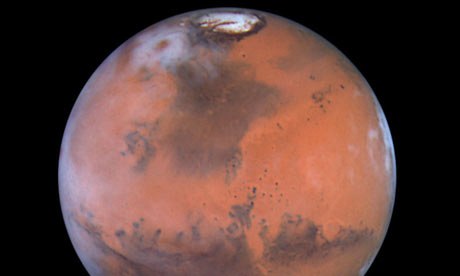Hunting ET: Astrobiology and the quest for extraterrestrial life
The discovery of life elsewhere in the Solar System would 'profoundly change our understanding of where we came from and our place in the cosmos', astrobiologist Lewis Dartnell told Sam Wong ahead of his public lecture on the subject this week

Methane, a possible signature of life, has been detected in the atmosphere of Mars. Photograph: Nasa Planetary Photojournal/PA
Is there anybody out there? That's the big question scientists are asking in the emerging field of astrobiology. Its practitioners bring together expertise from a variety of disciplines in their quest to determine whether there is life beyond our green and pleasant home planet.
"The question of whether we are alone in the universe or not is something that every single one of us has wondered about at one point," says Lewis Dartnell, an astrobiology researcher at University College London and author of Life In The Universe: A Beginner's Guide. "Whatever the answer, I think it would profoundly change our understanding of where we came from and our place in the cosmos."
At first glance the prospects of finding life elsewhere in our own solar system don't look good, since every planetary body other than our own is either scorching hot or ferociously cold. Then again, we know that on Earth life can flourish in the unlikeliest locations, from polar ice caps to hydrothermal vents reaching 113C.
The first place to look has naturally been our neighbouring planet, Mars. When Nasa dispatched two Viking spacecraft to land on the Red Planet in the 1970s, they sent equipment designed to carry out experiments to test whether there might be microorganisms in the Martian soil.
The instruments detected no trace of any organic chemicals. However, one experiment, called "labelled release", did produce a positive result. When a dilute solution of nutrients containing radioactive carbon atoms was added to a soil sample, carbon dioxide gas was given off that contained the same labelled carbon atoms.
This was taken by some to indicate that the nutrients must have been metabolised by a life form. But most scientists believe that the experiment was flawed, since the chemical reactions that it detected could occur without any biological assistance.
In 2003, the European Space Agency's Mars Express spacecraft detected traces of methane in Mars's atmosphere. More recently, vast plumes of the gas have been detected by Earth-based telescopes. Since the gas is highly unstable, this suggests that there must be some ongoing process that is producing methane on Mars. Although geological processes could account for it, the absence of any known volcanic activity on the planet raises hopes that subterranean microbes could be the source.
"Provided it was protected from the harsh radiation and chemical environment right on the surface of Mars, life there could remain safely dormant for long periods of time," says Dartnell. "Subterranean life, miles deep in the warmer Martian crust, may even be active still today, feeding off minerals in the rock like the hardy organisms on Earth."
Nasa is due to launch its most ambitious probe to date in 2011. The Mars Science Laboratory, christened Curiosity, aims to determine whether life has ever existed on the planet next door. Esa is also hoping to send a lander to Mars in 2018 to look for signs of life. In the more distant future, space scientists want to bring back a sample of Martian rock to Earth so that it can be investigated more thoroughly.
Further afield, the satellites of the gas giants are the locations that arouse most interest in astrobiologists. The icy surface of Jupiter's sixth moon, Europa, is covered with cracks just like polar ice on Earth, suggesting that it is continually breaking up and reforming. This could only be explained by the presence of liquid water underneath. The subsurface ocean could be kept warm by tidal forces resulting from Jupiter's gravitational pull.
"In the dark depths of our own oceans we find hardy microbial life forms surviving off nothing more than the inorganic chemicals spewing out of the Earth's crust," says Dartnell. "Just the same kind of life might be lurking beneath the icy crust of Europa."
The surface of Titan, the largest satellite of Saturn, is strikingly Earth-like. Photographs taken by the Cassini orbiter in 2004 revealed mountain ranges, dunes and even lakes – not lakes of water, admittedly, but astrobiologists think that the liquid methane on Titan's surface could support some sort of life form quite different from anything that exists on Earth.
"Any life on the surface of Titan would need to operate on an exotic biochemistry, based on liquid methane rather than water," says Dartnell.
Another of Saturn's moons, Enceladus, attracted the attention of astrobiologists when Cassini discovered plumes of water vapour and hydrocarbons spewing from beneath its icy surface, raising hopes that there might be underground water.
Last month Nasa reported that the plumes contain ammonia, which can allow water to remain liquid down to a temperature of minus 97 degrees Celsius.
The plumes also contain sodium – an exciting finding for astrobiologists like Dartnell. "It implies the plumes are coming from underground caverns of salty water, exactly the sort of environment that could provide the conditions for life."
Nasa and Esa have plans in the pipeline to send probes to both Jupiter and Saturn. Earlier this year they announced that the Europa Jupiter System Mission would be given priority over the Titan Saturn System Mission, with the former due to begin its six-year voyage in 2020.
Lewis Dartnell was our guest on this week's Science Weekly podcast, "What would an alien look like?". He will give a public lecture about astrobiology on Sunday at 5pm as part of the Your Universe event at University College London, a series of talks and activities starting on Thursday to celebrate the International Year of Astronomy 2009

No comments:
Post a Comment